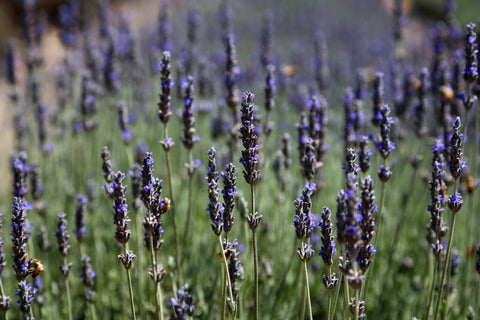This little flower from the mint family has been a fan favourite over the centuries for a very good reason. We are breaking down the history of lavender from its traditional medicinal purposes to perfumery and all the way to modern day science applications.
What is lavender?
Lavandula is a member of the mint family. It is native to countries bordering the Mediterranean Sea. Lavender grows as a small evergreen shrub with green leaves. The purple flowers grow on the bare stalks and produce small nutlet fruits. The fragrance of the plant is caused by the oil glands along the star-shaped trichomes or plant hairs.

French Lavender in Provence
French lavender is known as Lavandula stoechas, and it is amongst one of the most widely cultivated species. It is also sometimes called the ‘butterfly plant’ as the tip of the lavender plant can resemble a butterfly.

It can grow almost anywhere, but it is vulnerable when temperatures drop below -7°C. However, it extremely resilient to drought, and the plant has been growing in the country for thousands of years. It is no surprise then that the flower has become a symbol of Provence itself.
The best time to take in the stunning views of the lavender fields in Provence is from June to the beginning of August. As a general rule, the higher the altitude of the field the later the flowers will bloom. Iconic sights like the Notre-Dame de Senanque, a 12th-century abbey near Sault lined in rows of lavender, are not to be missed when visiting the region.
Lavender & Ancient Medicine
The first uses of lavender recorded in ancient cultures were medicinal in nature. Dioscorides, an ancient Greek physician, believed that eating lavender would relieve indigestion, sore throats, and headaches. There is also evidence of lavender being used in the mummification process of ancient Egyptians.
Lavender was also commonly found in bath houses in ancient Rome. In fact, the Latin verb for ‘to wash’ is lavare.
Over time, three common uses of lavender developed across different cultures.

One of these uses is of lavender as an anti-septic. Romans bathed in it. Grave robbers in England would also wash in lavender to try to avoid the plague. By the 1930s, René-Maurice Gattefossé, a French chemist, used lavender oil to attempt to heal a burn. Even during World War Two, lavender was often used by doctors to treat soldiers wounds.
The other prevalent use of lavender was as a calming aid. Traditional medicinal practices in Asia noted the ‘cooling’ effect of lavender, which helped people relax and release tension in their bodies. Charles VI of France slept with lavender in his pillow to help him sleep. An English herbalist, John Parkinson, believed lavender could be used to help any ailment of the head or brain.
The last common use of lavender, though less scientific in nature, was to protect against evil. Arguably better hygiene, and perhaps the addition of lavender in bathing or other treatments, was more efficient in warding off disease - lavender was still often hung above doors to protect against evil spirits. Irish brides wore lavender under their garters to protect them from witchcraft. In London, lavender was sold as a good luck charm on the streets in the nineteenth century.
Lavender Oils & Perfumery
Outside of the realm of healing, lavender also became a preferred fragrance. Supposedly, Cleopatra rubbed lavender on her skin, which helped to seduce lovers like Julius Caesar and Marc Antony. But how exactly is lavender distilled into a fragrance that we find in our soaps, perfumes, and lotions?
Lavender oil is produced during a chemical process called distillation. The oil found on the plant hairs is turned into vapor, and then subsequently condensed back into oil. It is typically colourless, but it may be yellow. The liquid is composed of linalyl acetate, linalool, pinene, limonene, geraniol, and cineole. This oil can then be added during the soap making process or mixed in while creating a perfume.
Lavender Today
Lavender remains a hugely popular scent today, but it isn't often used to treat wounds anymore. The rapid advancement of modern science has significantly reduced the use of lavender in day-to-day practices, but there is still evidence of the positive benefits lavender may have on our brains and nervous system.
It seems that Charles VI may have had the right idea sleeping on a pillow stuffed with lavender. There is recent evidence that suggests lavender may help you get a better night’s sleep. Though sample sizes in the studies reviewed were small, participants found an increase in deep sleep and reduced awakening throughout the night.
Another study looked at linalool, an alcohol found in lavender oils, which demonstrated calming properties when inhaled. Researchers suggested further studies to examine how linalool might be used as an alternative treatment for people suffering with anxiety or to help relax patients undergoing surgery before receiving their general anesthetics.
Lavender is so much more than a scent, and it has played an important role throughout human history as more than just a flower. Are you a fan of lavender?





